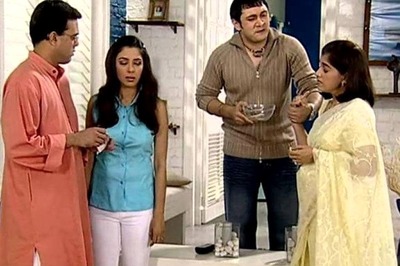
views
Kawaii Aesthetic: The Basics
The kawaii aesthetic focuses on cuteness. Kawaii, the Japanese cultural phenomenon emphasizing cuteness, childlike innocence, charm, and simplicity, is expressed through the Japanese words かわいい (kawaii) , which means "cute" or "adorable." The kawaii look is characterized by soft, pastel colors and rounded shapes. It often features elements that convey vulnerability, such as large eyes and small mouths. This aesthetic has become a prominent aspect of Japanese popular culture, influencing entertainment, fashion, advertising, and product design. Kawaii culture began to take off in the 1970s. The rise of cute characters in manga, anime, and related merchandise, exemplified by Sanrio's creation of Hello Kitty in 1974, was driven by youth culture.
Where did the kawaii aesthetic come from?
Kawaii culture traces its origins to the Taisho era (1912-1926). When a youthful, handwritten style known as “maru-moji” gained popularity among Japanese schoolgirls, this rounded, childlike script stood in contrast to the more traditional, rigid writing styles of the time. The rounded, soft aesthetic of maru-moji reflects the influence of Japan's broader "kawaii" (cute) culture, which permeates many aspects of everyday Japanese life, including written communication.
Hello Kitty revolutionized the Kawaii aesthetic. The 1974 debut of Sanrio's iconic “Hello Kitty” character marked a pivotal moment in the rise of Kawaii culture. The global popularity and success of Hello Kitty helped propel this distinctive Japanese aesthetic into mainstream consciousness around the world.
Kawaii Aesthetic in Popular Culture and Media
Manga and anime Kawaii has long been a concept and aesthetic used in various manga and anime shows and series. Series featuring kawaii as a main theme include: Afro-ken Animal Crossing Bonobono Charmmy Kitty Chi's Sweet Home CoCO & NiCO Cocotama Daisuki! Hello Kitty Gudetama Hamster Club Hamtaro Ichigo Mashimaro Kiki and Lala Kemono Friends Lalala Lala-chan Mameshiba Mermaid Melody Mitchiri Neko Mochi Mochi Panda Nekopara Ojamajo Doremi Pochacco Pretty Cure Sailor Moon School Babysitters Sylvanian Families Tamagotchi! Yuru Yuri
Music Kawaii music captures innocence and joy. Kawaii fans are drawn to music that transports them to a realm where anxieties melt away and burdens disappear. The melodies they cherish are sweet, whimsical like a fairy tale, and soothing. This music aims to envelop the senses, cultivating an oasis of serenity amidst the chaos of everyday life.
Visuals Kawaii visuals often feature a range of pastel colors, with white serving as a neutral and pink as the most common hue. However, the aesthetic is not limited to this color palette, as seen in Decora-style visuals. Lighting in kawaii imagery is consistently bright, with minimal to no shadows present. Photo editing is extensively used, as people frequently add stickers, sparkles, enlarge eyes, and smooth the overall image to achieve a more maximalist, hyper-cute look.
Hand-writing In the 1970s, the rising popularity of the kawaii aesthetic inspired a new style of writing among Japanese teenage girls. These girls would write laterally using mechanical pencils, which produced fine, uniform lines in contrast to the traditional vertical Japanese script with varied thickness. They also incorporated large, rounded characters, as well as small illustrations like hearts, stars, emoticons, and Latin letters into their handwriting. While this "cute" writing style was visually appealing, it was often difficult to read. Consequently, many schools banned the practice, sparking controversy. However, during the 1980s, this whimsical script was widely adopted by magazines, comics, packaging, and advertising, especially for products aimed at children or featuring "cute" aesthetics.
Merchandise The concept of "kawaii" has influenced a variety of Japanese products, including popular candies like Hi-Chew, Koala's March, and Hello Panda. Manufacturers often incorporate cute design elements such as hearts, flowers, stars, and rainbows to intentionally add an element of cuteness to their products. This aesthetic of cuteness is ubiquitous in Japan, seen everywhere from major corporations to local businesses and even government offices. Many companies, both large and small, use adorable mascots to market their goods and services to the public. For instance: Pikachu, the iconic Pokémon character, is prominently featured on the sides of ten ANA passenger jets, which are known as the "Pikachu Jets." Japan's prefectures, cities, and cultural institutions have created a host of adorable mascot characters known as yuru-chara to boost tourism. Among the most beloved are Kumamon, the mascot for Kumamoto Prefecture, and Hikonyan, representing the city of Hikone. Certain Japanese police departments have adopted kawaii-style mascot characters, which they occasionally display on the exterior of their police kōban (neighborhood police stations).
Idols Japanese idols are young media personalities, typically in their teens and twenties, who are considered especially attractive or cute. For a period ranging from several months to a few years, they will regularly appear across various media platforms as singers in pop groups, bit-part actors, TV personalities, magazine models, and in advertisements. However, not every young celebrity is considered an "idol." Those who cultivate a more rebellious image, such as many rock musicians, often reject the "idol" label.
Variations of the Kawaii Aesthetic
Lolita The Lolita fashion style is highly recognizable in Japan, drawing inspiration from Victorian and Rococo periods. Girls who embrace this look aim to achieve a cute, innocent, and beautiful "porcelain doll" aesthetic, incorporating elements of gothic style. This is accomplished through the use of lace, ribbons, bows, ruffles, bloomers, aprons, and ruffled petticoats. A subset of Lolita fashion, known as Sweet Lolita, features even more ribbons, bows, and lace, often in pastel or other light colors. Head-dresses like giant bows or bonnets are also characteristic of this style. Wearers may use lighter makeup to achieve a more natural look, and curled hair extensions or eyelash extensions are popular for the baby doll appearance.
Kimo-kawaii/Yami-kawaii Kimo-kawaii, also known as "creepy-cute" or "gross-cute" in Japanese, combines kawaii aesthetics with stylistic elements of horror and the macabre, creating a distinct look. This style emerged in the 1990s as some people grew disinterested in cute and innocent character designs and fashion. Kimo-kawaii is typically achieved by wearing creepy or unsettling clothes and accessories that emphasize dark themes and colors. In the mid-2010s, a related style called yami-kawaii or "sickly-cute" also emerged. Yami-kawaii fashion uses black, deep purple, and gray colors on melancholic motifs like teardrops, broken hearts, and pill capsules to emphasize themes of mental health, vulnerability, and emotional darkness—in contrast to the more overtly disturbing elements of kimo-kawaii.
Fairy Kei Fairy Kei is a youthful fashion style inspired by 1980s aesthetics, evoking a dreamy, nostalgic feel. Outfits typically feature pastel colors, angelic motifs, toys, and other cute elements drawn from iconic 1980s and early 1990s Western toy lines like Polly Pocket, My Little Pony, Strawberry Shortcake, Rainbow Brite, Barbie, Wuzzles, and Care Bears. Pastel-colored hair is common, though natural hair is also popular, often styled simply and accessorized with cute or pastel bows. Key Fairy Kei pieces include vintage sweaters, cardigans, varsity jackets, tutus, mini skirts, tights, over-the-knee socks, sneakers, and tea party shoes.
Decora Decora is a fashion style characterized by the extensive use of "decorations" such as multicolored hair pins, bracelets, rings, necklaces, and other accessories. The goal of this style is to create a vibrant, exaggerated appearance. By layering numerous accessories, the fashion trend often takes on a childlike aesthetic that some may find off-putting or inauthentic. However, others appreciate the positivity, innocence, and lightheartedness associated with the kawaii style. Decora shares crossover elements with the Fairy Kei fashion subculture, which also incorporates toys and multicolored clothing.
Kawaii men The kawaii fashion trend is typically associated with girls, but some men do participate as well. However, men wearing masculine kawaii accessories is quite uncommon. Instead, male participants often cross-dress as kawaii women by wearing wigs, false eyelashes, makeup, and feminine kawaii clothing.
How to Get the Kawaii Aesthetic
Embrace a sweet, youthful style. Dress in the cutest, most vibrant clothing you can find. Look for ruffles, frills, lolita dresses, pastel colors, bloomer shorts, suspender skirts, and dungarees—anything that makes you feel adorable and full of life. Stores like Kawaii Babe offer a fantastic selection to start your journey towards a truly kawaii aesthetic.
Consider circle contact lenses. Circle contact lenses can dramatically enlarge your eyes, giving them the wide-eyed, doll-like appearance of anime characters. With a vast selection of styles, shapes, and colors available, you can easily find circle lenses to achieve your desired look.
Keep your makeup fresh and light. Achieve a kawaii makeup look by focusing on an innocent, glowing aesthetic. Highlight your features with bright pink blush just under the eyes, shimmery highlighter, clean winged eyeliner to open up the eyes, and a pink sparkly lip gloss. Avoid dramatic looks like smokey eyes and dark red lips, as they will clash with the youthful, angelic vibe you're going for.
Jazz up your nails with sparkles and pastel colors. Your nails offer a canvas to showcase your personal style. Embellishing them with rhinestones, glitter, or a classic French manicure can add a charming, polished touch. If you struggle with biting your nails, trying out some temporary false nails can be a fun way to experiment with different looks.
Capture a youthful, playful look with kawaii-inspired hairstyles. Pigtails, headbands, bows, and braids are all charming options that complement a wide range of kawaii fashions. For a low-commitment way to experiment with bold colors, try wearing realistic wigs made from high-quality kanekalon fiber. These wigs can even be heat-styled to create your desired look.
Use anime for inspiration. Anime and manga offer a wealth of inspiration for creating cute, whimsical aesthetics. In particular, the magical girl genre provides excellent insight into the kawaii style and sensibility. Drawing from the vibrant visuals and character designs of these animated works can help cultivate a charming, imaginative aesthetic.




















Comments
0 comment